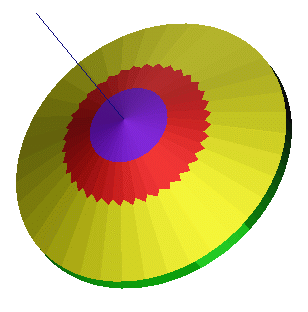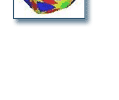|
|

 Examples Examples
Wulffman is a versatile tool capable of illustrating an infinite
variety of crystal shapes. A few examples are given below that
demonstrate some of the basic program features listed above.
- Simple Wulff Shape Construction
- The Simple Cube :
Crystal system: Cubic
Point Group: Any!
Facets: [100]
Energy: 1.0
Wulff shape
: Cube
- Truncated Octahedron :
Crystal systems: Cubic
Point Group: m3m (for example)
Facets: [100] and [111]
Energies: 1.0 and 0.85
Wulff
shape : Cuboctohedron
- A hexagonal Pencil :
Crystal system: Hexagonal
Point Group: 6/mmm
Facets: [431], [100], [210]
Energies: 1.0, 0.86, 0.91
Wulff shape
: Modified Dihexagonal Dipyramid
- A trigonal Lozenge :
Crystal system: Trigonal
Point Group: 3_m
Facets: [14n], n=6-12
Energies: 0.65, 0.59, 0.55, 0.52, 0.50, 0.485, 0.48
Wulff shape
: Modified Hexagonal Scalenohedron
- Buckyballs! :
Crystal system: Icosahedral
Point Group: 235
Facets: [111], [1 1.62 0]
Energies: 1.0, 1.02
Wulff shape
: Buckyball
- Custom Flying Saucer :
Crystal system: Custom
Point Group: 37-fold roto-inversion around [001]
Facets: [148], [100], [217], [124]
Energies: 0.85, 1.63, 0.87, 0.85
Wulff shape
: Flying saucer (?)
- Dynamic Wulff Shapes : Surface energy
anisotropy
- Octahedron --> Truncated Octahedron -->
Dodecahedron:
Crystal system: Cubic
Point group: m3_m
Transformation: The beginning structure is an
octahedron generated by [111] facets. [100] facets are added, and
their surface energy is lowered until the truncated octahedron
(cuboctahedron) results. [110] facets with low energy are included,
and as their energy is decreased relative to [100] and [111], the
dodecahedron results.
Graphics:
Animated GIF (170k)
- Stars and Icosahedra Forever:
Crystal system: Icosahedral
Point group: 235
Transformation: A general icosahedral form with 60
[132] facets is generated. [111] facets are included and their energy
is decreased until the regular icosahedra results.
Graphics:
Animated GIF (270k)
- Unique Crystal Planes:
Crystal system: Cubic
Point group: 432
Facets:
Unique ("slice") plane: [112]
Normal facets: [149], [216], [100]
Description: Decreasing the energy of the unique plane [112]
progressively slices off more and more of the Wulff shape. If the
[112] facet had not been unique, 24 equivalent planes would have been
generated.
Graphics: Still GIF (11k)
and Animated GIF
(308k)
- Isotropic Surfaces
Crystal system: Cubic
Point group: m3_m
Facets: [100] (Energy = 0.85)
Boundary polytope: 500 facets, Skew = 0, Energy = 1.0
Description: In the absence of a bounding polytope, [100]
facets under cubic symmetry generate a cube Wulff shape. By adding an
isotropic boundary polytope with a slightly higher energy, the corners
end edges of the cube are cut off and replaced by smooth surfaces. The
Wulff shape is effectively the intersection of a sphere and
a cube.
Graphics: Still GIF
(30k) and animated GIF (335k)
- Naturally-Occurring Materials
The following are examples of Wulff shapes found to occur
in nature (from Elementary Crystallography
, M. Buerger, MIT Press, 1956):
- Sulfur: An
example of development in class mmm
- Eglestonite
: Hg4OCl2, an example of form development in class 43_m.
- Beryl :
Be3Al2Si6O18, Beryllium Aluminum Silicate, a
semi-precious mineral, represents
form development in class 6mm.
- Rutile : TiO2,
Titanium Dioxide, an example of form development
in class 4mm.
Center for Theoretical and Computational Materials Science, NIST
Questions or comments:
[email protected]
|
|





 Examples
Examples